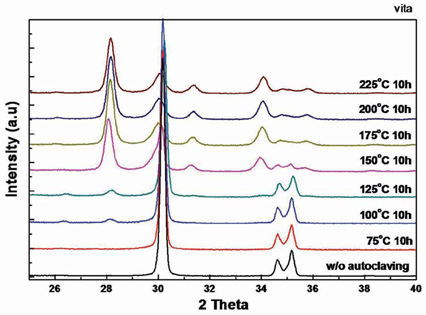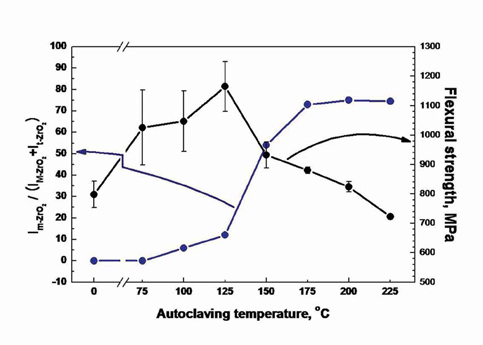J Adv Prosthodont.
2009 Nov;1(3):113-117.
The effect of low temperature aging on the mechanical property & phase stability of Y-TZP ceramics
- Affiliations
-
- 1Department of Prosthodontics, Graduate School, Seoul National University, Seoul, Korea. proshan@snu.ac.kr
Abstract
- STATEMENT OF PROBLEM: Recently Yttrium-stabilized tetragonal zirconia polycrystal (Y-TZP) has been introduced due to superior flexural strength and fracture toughness compared to other dental ceramic systems. Although zirconia has outstanding mechanical properties, the phenomenon of decrease in the life-time of zirconia resulted from degradation in flexural strength after low temperature aging has been reported. PURPOSE: The objective of this study was to investigate degradation of flexural strength of Y-TZP ceramics after various low temperature aging treatments and to evaluate the phase stability and micro-structural change after aging by using X-ray diffraction analysis and a scanning electron microscope (SEM). MATERIAL AND METHODS: Y-TZP blocks of Vita In-Ceram YZ (Vita Zahnfabrik, Bad Sackingen, Germany) were prepared in 40 mm (length) x 4 mm (width) x 3 mm (height) samples. Specimens were artificially aged in distilled water by heat-treatment at a temperature of 75, 100, 125, 150, 175, 200, and 225degrees C for 10 hours, in order to induce the phase transformation at the surface. To measure the mechanical property, the specimens were subjected to a four-point bending test using a universal testing machine (Instron model 3365; Instron, Canton, Mass, USA). In addition, X-ray diffraction analysis (DMAX 2500; Rigaku, Tokyo, Japan) and SEM (Hitachi s4700; Jeol Ltd, Tokyo, Japan) were performed to estimate the phase transformation. The statistical analysis was done using SAS 9.1.3 (SAS institute, USA). The flexural strength data of the experimental groups were analyzed by one-way analysis of variance and to detect statistically significant differences (alpha= .05). RESULTS: The mean flexural strength of sintered Vita In-Ceram YZ without autoclaving was 798 MPa. When applied aging temperature at below 125degrees C for 10 hours, the flexural strength of Vita In-Ceram YZ increased up to 1,161 MPa. However, at above 150degrees C, the flexural strength started to decrease. Although low temperature aging caused the tetragonal-to-monoclinic phase transformation related to temperature, the minimum flexural strength was above 700 MPa. CONCLUSION: The monoclinic phase started to appear after aging treatment above 100degrees C. With the higher aging temperature, the fraction of monoclinic phase increased. The ratio of monoclinic/tetragonal + monoclinic phase reached a plateau value, circa 75% above 175degrees C. The point of monoclinic concentration at which the flexural strength begins to decrease was between 12% and 54%.
MeSH Terms
Figure
Reference
-
1. Kosmac T, Oblak C, Jevnikar P, Funduk N, Marion L. The effect of surface grinding and sandblasting on flexural strength and reliability of Y-TZP zirconia ceramic. Dent Mater. 1999. 15:426–433.2. Piconi C, Maccauro G. Zirconia as a ceramic biomaterial. Biomaterials. 1999. 20:1–25.3. Subbarao EC, Maiti HS, Srivastava KK. Martensitic transformation in zirconia. Phys Status Solidi Series A. 1974. 21:9–40.4. Kobayashi K, Kuwajima H, Masaki T. Phase change and mechanical properties of ZrO2-Y2O3 solid electrolyte after ageing. Solid State Ionics. 1981. 3/4:489–493.5. Chevalier J, Cales B, Drouin JM. Low-temperature aging of Y-TZP ceramics. J Am Ceram Soc. 1999. 82:2150–2204.6. Lilley E. Tressler RE, McNallan M, editors. Review of low temperature degradation in Y-TZPs. Ceramic transaction: corrosion and corrosive degradation of ceramics. 1990. Westerville: American Ceramics Society;387–407.7. Lawson S. Environmental degradation of zirconia ceramics. J Eur Ceram Soc. 1995. 15:485–502.8. Deville S, Chevalier J, Fantozzi G, Bartolome JF, Requena J, Moya JS. Low-temperature ageing of zirconia-toughened alumina ceramics and its implication in biomedical implants. J Eur Ceram Soc. 2003. 23:2975–2982.9. Yoshimura M. Phase stability of zirconia. Am Ceram Sot Bull. 1988. 67:1950–1955.10. Lube T, Manner M, Danzer R. The miniaturization of the 4-point bend test. Fatigue Fract. Engng Mater Struct. 1997. 20:1605–1616.11. Garvie RC, Nicholson PS. Phase analysis in zirconia systems. J Am Ceram Soc. 1972. 55:303–305.12. Emsley J. The Elements. 1991. 2nd ed. Oxford, UK: Oxford University Press.13. Cales B, Stefani Y, Lilley E. Long-term in vivo and in vitro aging of a zirconia ceramic used in orthopaedy. J Biomed Mater Res. 1994. 28:619–624.14. Shimizu K, Oka M, Kumar P, Kotoura Y, Yamamuro T, Makinouchi K, Nakamura T. Time-dependent changes in the mechanical properties of zirconia ceramic. J Biomed Mater Res. 1993. 27:729–734.15. Pittayachawan P, McDonald A, Petrie A, Knowles JC. The biaxial flexural strength and fatigue property of Lava Y-TZP dental ceramic. Dent Mater. 2007. 23:1018–1029.16. Chevalier J, Deville S, Münch E, Jullian R, Lair F. Critical effect of cubic phase on aging in 3mol% yttria-stabilized zirconia ceramics for hip replacement prosthesis. Biomaterials. 2004. 25:5539–5545.17. Cales B. Zirconia as a sliding material: histologic, laboratory, and clinical data. Clin Orthop Relat Res. 2000. 379:94–112.18. Deville S, Gremillard L, Chevalier J, Fantozzi G. A critical comparison of methods for the determination of the aging sensitivity in biomedical grade yttria-stabilized zirconia. J Biomed Mater Res B Appl Biomater. 2005. 72:239–245.19. Suárez MJ, Lozano JF, Paz Salido M, Martínez F. Three-year clinical evaluation of In-Ceram Zirconia posterior FPDs. Int J Prosthodont. 2004. 17:35–38.20. Oblak C, Jevnikar P, Kosmac T, Funduk N, Marion L. Fracture resistance and reliability of new zirconia posts. J Prosthet Dent. 2004. 91:342–348.21. Roebben G, Basu B, Vleugels J, Van der Biest O. Transformation-induced damping behaviour of Y-TZP zirconia ceramics. J Eur Ceram Soc. 2003. 23:481–489.22. Guazzato M, Quach L, Albakry M, Swain MV. Influence of surface and heat treatments on the flexural strength of Y-TZP dental ceramic. J Dent. 2005. 33:9–18.23. Wen MY, Mueller HJ, Chai J, Wozniak WT. Comparative mechanical property characterization of 3 all-ceramic core materials. Int J Prosthodont. 1999. 12:534–541.24. Ardlin BI. Transformation-toughened zirconia for dental inlays, crowns and bridges: chemical stability and effect of low-temperature aging on flexural strength and surface structure. Dent Mater. 2002. 18:590–595.25. Aboushelib MN, de Jager N, Kleverlaan CJ, Feilzer AJ. Microtensile bond strength of different components of core veneered all-ceramic restorations. Dent Mater. 2005. 21:984–991.
- Full Text Links
- Actions
-
Cited
- CITED
-
- Close
- Share
- Similar articles
-
- Biaxial flexural strength and phase transformation of Ce-TZP/Al2O3 and Y-TZP core materials after thermocycling and mechanical loading
- An experimental study on hydrothermal degradation of cubic-containing translucent zirconia
- Effect of hydrofluoric acid-based etchant at an elevated temperature on the bond strength and surface topography of Y-TZP ceramics
- Mechanical behavior and microstructural characterization of different zirconia polycrystals in different thicknesses
- Change of phase transformation and bond strength of Y-TZP with various hydrofluoric acid etching




